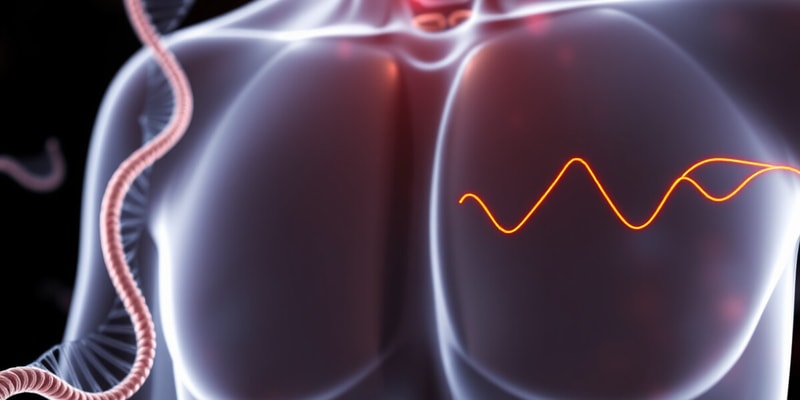Podcast Beta
Questions and Answers
Which of the following conditions is a common cause of primary hypothyroidism?
What is the expected laboratory finding in a patient with secondary hypothyroidism?
Which of the following symptoms is NOT typically associated with hypothyroidism?
What characterizes myxedema in hypothyroidism?
Signup and view all the answers
What is a potential precipitating factor for myxedema coma?
Signup and view all the answers
What leads to primary hyperthyroidism?
Signup and view all the answers
Which laboratory finding differentiates primary hyperthyroidism from secondary hyperthyroidism?
Signup and view all the answers
What is a characteristic clinical manifestation of hyperthyroidism?
Signup and view all the answers
Which treatment option is associated with the complications of hypothyroidism?
Signup and view all the answers
What role does the pituitary gland play in secondary thyroid disorders?
Signup and view all the answers
What occurs during the follicular phase of the menstrual cycle?
Signup and view all the answers
How long does the luteal phase last in the menstrual cycle?
Signup and view all the answers
What is the main event that occurs during ovulation?
Signup and view all the answers
What is the duration of the entire menstrual cycle?
Signup and view all the answers
What role does estrogen play during the menstrual cycle?
Signup and view all the answers
What is the primary cause of Addison's disease?
Signup and view all the answers
Which symptoms are associated with adrenal insufficiency?
Signup and view all the answers
What evaluation findings are typical in a patient with Addison's disease?
Signup and view all the answers
In secondary adrenal insufficiency, what is the primary issue?
Signup and view all the answers
What is a common characteristic of pheochromocytoma?
Signup and view all the answers
What syndrome is most commonly associated with pheochromocytoma?
Signup and view all the answers
What treatment is generally required for a patient diagnosed with primary adrenal insufficiency?
Signup and view all the answers
What should be done in cases of abrupt withdrawal from exogenous glucocorticoids?
Signup and view all the answers
What is a common cause of vulvitis?
Signup and view all the answers
Which of the following is NOT a primary infection causing vaginitis?
Signup and view all the answers
What can happen if pelvic inflammatory disease (PID) is left untreated?
Signup and view all the answers
Which microorganism is most commonly associated with cervicitis?
Signup and view all the answers
Which condition is characterized by an overgrowth of lactobacillus?
Signup and view all the answers
What is the significance of the 'chandelier sign' during a physical exam?
Signup and view all the answers
Which of the following describes a complex ovarian cyst?
Signup and view all the answers
What happens to vaginal pH after menopause, and what is the implication?
Signup and view all the answers
Study Notes
Primary and Secondary Thyroid Disorders
- Primary thyroid disorders involve direct disease or dysfunction of the thyroid gland, leading to altered thyroid hormone (TH) levels and secondary feedback effects on pituitary thyroid-stimulating hormone (TSH) levels.
- Secondary thyroid disorders originate from dysfunction of the pituitary gland, specifically affecting TSH production.
Hypothyroidism vs. Hyperthyroidism
Thyrotoxicosis
- Characterized by increased TH levels, regardless of cause.
- Primary hyperthyroidism includes conditions such as Graves' disease, toxic multimodal goiter, solitary toxic adenoma, and follicular thyroid carcinoma.
- Secondary hyperthyroidism is due to TSH-secreting pituitary adenomas.
Clinical Manifestations
- Hyperthyroidism causes increased metabolic rate, heat intolerance, and heightened sensitivity to sympathetic nervous system (SNS) stimulation.
Evaluation
- In primary hyperthyroidism, T3 and T4 levels are elevated while TSH levels are decreased.
- In secondary hyperthyroidism, TSH levels are normal or increased alongside elevated T3 and T4 levels.
Treatment Options
- Treatment strategies for hyperthyroidism include anti-thyroid medications, radioactive iodine therapy, and surgery, with a potential complication of hypothyroidism post-treatment.
Hypothyroidism
- Primary hypothyroidism, the most prevalent thyroid dysfunction, features reduced production of TH (T3 and T4) and increased TSH secretion.
- Causes include autoimmune thyroiditis (Hashimoto's), iatrogenic factors (surgery or radiation), medications, and iodine deficiency.
- Secondary hypothyroidism arises from pituitary or hypothalamic failures, such as pituitary tumors, traumatic brain injury (TBI), subarachnoid hemorrhage, and pituitary infarction.
Clinical Manifestations
- Symptoms of hypothyroidism include low basal metabolic rate, cold intolerance, diastolic hypertension, and myxedema, which involves non-pitting edema due to protein and mucopolysaccharides.
- Myxedema coma is a medical emergency marked by diminished level of consciousness, hypoventilation, hypotension, hypoglycemia, and lactic acidosis.
Evaluation
- In primary hypothyroidism, TSH levels are increased with low TH levels, while secondary hypothyroidism shows low TH levels alongside normal or low TSH levels.
Treatment
- Hormone replacement therapy, typically with Synthroid, is the standard treatment for hypothyroidism.
Adrenal Hypofunctioning
- Addison's disease, marked by hypocortisolism and adrenal insufficiency, results from an inability to synthesize and secrete adrenocortical hormones (cortisol and aldosterone).
- Causes include autoimmune destruction, infections, infiltrative diseases, or adrenal hemorrhage, leading to inadequate hormone synthesis and elevated ACTH levels due to lost negative feedback.
- Symptoms include weakness, fatigue, skin changes, anorexia, dehydration, hyperkalemia, postural hypotension, and salt craving.
Evaluation and Treatment
- Diagnosis involves reduced cortisol with increased ACTH levels, hypoglycemia, and hyperkalemia.
- Treatment consists of lifelong glucocorticoid and mineralocorticoid replacement, with increased dosages during stress.
Diseases Associated with Pheochromocytoma and Paragangliomas
- Pheochromocytomas are catecholamine-secreting tumors often linked to von Hippel-Lindau syndrome, MEN-2, and neurofibromatosis-1, with a malignancy rate of 10-20%.
- Symptoms related to catecholamine excess include hypertension, headaches, sweating, palpitations, and tachycardia.
- Women may have delayed diagnoses due to symptoms mimicking anxiety.
Menstrual Cycle Overview
- The menstrual cycle lasts approximately 28 days and consists of follicular (first 14 days) and luteal phases (last 14 days) with ovulation occurring between the two.
- Follicular Phase: Development of ovarian follicles; includes estrogen feedback loops.
- Luteal Phase: Post-ovulation; preparation of the endometrium for potential implantation.
Vulvitis, Vaginitis, and Other Infections
- Vulvitis is inflammation of the female external genitalia caused by irritants or infections.
- Vaginitis is the most common condition and includes bacterial vaginosis, Candida albicans, and trichomoniasis.
- Cervicitis is inflammation of the cervix often due to sexually transmitted infections (STIs) like gonorrhea and chlamydia.
Pelvic Inflammatory Disease (PID)
- PID is acute inflammation of the reproductive tract possibly caused by STI migration.
- Symptoms and signs include abdominal pain, fever, and painful cervical motion ("chandelier sign").
- Untreated PID can lead to infertility, abscess formation, and chronic pelvic pain.
Studying That Suits You
Use AI to generate personalized quizzes and flashcards to suit your learning preferences.
Related Documents
Description
This quiz explores primary and secondary thyroid disorders, focusing on how alterations in the thyroid and pituitary glands can lead to dysfunction. Additionally, it compares and contrasts hypothyroidism and hyperthyroidism, including aspects of thyrotoxicosis.





